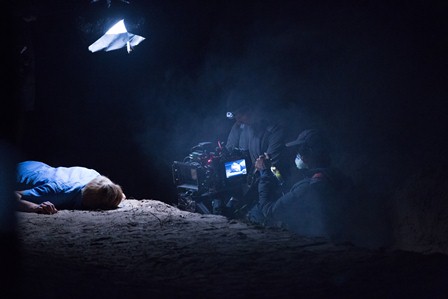The Pretend One shoot in rural Queensland
Cinematographer, Robert Morton, has given an inside look into the making of new Australian feature film, The Pretend One.
The film, which is due for release in 2016, was shot on a cotton farm in rural Queensland with Sony PXW-FS7 cameras.
It was directed and produced by Tony Prescott and stars Geraldine Hakewill, Michael Whalley, Benedict Wall and David Field.
Director of photographry, Morton, has worked on The Great Gatsby in the camera department; as cinematographer on documentaries How to Fall in Love With a Stranger, Legacy: A Ride to Congquer Motor NeuroneDisease and TV movie Clean and Jerk.
Morton said the shooting schedule was ambitious.
"Given the limited amount of shoot days for the production phase, we employed a two-camera setup for a lot of scenes," he said.
"This allowed us to get the coverage we needed quickly. Primarily, we wanted a camera with a cinematic look that was more lightweight and less cumbersome than other cameras on the market, so the FS7 was ideal."
He said there were also a number of intricate Steadicam shots.
"The FS7’s lightweight design meant that we could handle them with ease," he said.
"We also required a camera system that could record off speed, shoot low light or natural light and work quickly in changing lighting conditions and needed to be able to switch between PL primes and EF zoom lenses for particular shots.
"The film also included a number of VFX elements from green screen composites to sky replacement. All in all the FS7 ticked all our boxes.”
According to Morton, the FS7s were also very maneuverable and could shift setups really quickly.
"This also helped when transferring to Steadicam or a car mount," he said.
"There were other major advantages to using FS7s such as the fact that we wanted a camera that was 4K and capable of recording up to 60fps, had internal Neutral Density filters to minimise filter changes when exterior lighting conditions changed plus had good colour and a wide dynamic range."
Morton has recently also shot two 4K dramatic short films with the FS7 for the Australian National Maritime Museum inside the Onslow submarine and Vampire warship as part of their new $8 million installation at Darling Harbour.
He has shot a variety of commercial, music video and documentary projects with the FS7 including the latest Nature’s Own brand campaign.
The Sony Alpha mount allowed for many different lens mounting options, changing between different mounts quickly.
The bit depth of the camera in conjunction with the slog2 produced fine gradation in colour and contrast, Morton said.
"The Pretend One was shot internally with 4K XAVC–I codec as opposed to RAW for several reasons," Morton said.
“Though it would have been a preference to shoot RAW as I have done in situations where compression and colour subsampling were critical to the final result, we weighed up the benefits of shooting RAW for The Pretend One and decided against it due to the data requirements.
"In saying that, the 4K XAVC-I 10bit 42:2 codec is a data efficient codec which holds up well with the slog2 gamma encoding.”
Morton said the cameras were set up in full production mode; matte boxes, remote focus, remote video and audio, Vlock battery plates, PL Zeiss MK3 Super Speeds.
"We also employed a quarter glimmer glass that gave the images a soft edged, blooming highlight with a rich image," he said.
The cameras were employed for a wide range of coverage including handheld, Steadicam, dollies, car (and tractor) rigs.
The shoot included a lot of exterior filming at specific time of day.
Morton said it was important that the camera rendered dynamic range, colour, contrast and textures.
“This way we accurately and beautifully represented the landscape the characters inhabit," he said.
"The majority of the film was shot hand-held with the exception of car-mounted shots and some establishing landscapes and scene master wides to give a strong sense of place."
There were a lot of broad sweeping exterior shots of the Queensland landscape, while the interiors were largely set in an old farm house and rural pub.
Morton also filmed long complicated Steadicam shots, wide planametric shots, car mounts, hand-held and composed dialogue scenes.
"The FS7 offers a cinematic feel, that coupled with the MK3 Super speeds gave beautiful soft images comparable to the best digital cameras on the market," he said.
"Some of the shoot days had up to ten minutes of screen time scheduled for the day and the FS7’s lightweight nature and ease of operation meant the time between setups allowed us to achieve all scheduled shots.
"Light sensitivity was also outstanding meaning that we could shoot in very natural low light whilst still having a lot of detail, this allowed us to the versatility of shooting well into last light on the epic sunset days."


